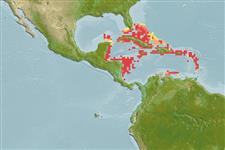Environment: milieu / climate zone / depth range / distribution range
Ecología
marino demersal; rango de profundidad 1 - 27 m (Ref. 26268). Tropical; 27°N - 10°N, 89°W - 60°W (Ref. 26268)
Western Central Atlantic: Widespread through insular regions of the Caribbean Sea, including Glover's Reef, St. Eustatius, St. Barthelemy, and the French West Indies. Rarely captured along the continental margins of the Caribbean.
Length at first maturity / Tamaño / Peso / Age
Maturity: Lm ?, range 3 - ? cm
Max length : 4.3 cm SL macho / no sexado; (Ref. 53028); 5.7 cm SL (female)
Radios blandos dorsales (total) : 76 - 77; Radios blandos anales: 61 - 62. Slender, small; pale with distinct, dark ocellated spots near rear of dorsal and anal fins.
Inhabits sandy substrates, also those submerged beds of aquatic vegetation, in clear shallow waters near coral reefs. Little is known of its biology since its captured infrequently and generally in small numbers; most captures were a single fish (Ref. 26268).
Life cycle and mating behavior
Maturities | Reproducción | Spawnings | Egg(s) | Fecundities | Larva
Böhlke, J.E. and C.C.G. Chaplin, 1993. Fishes of the Bahamas and adjacent tropical waters. 2nd edition. University of Texas Press, Austin. (Ref. 5521)
IUCN Red List Status (Ref. 130435)
Threat to humans
Harmless
Human uses
Pesquerías: sin interés
Herramientas
Special reports
Download XML
Fuentes de Internet
Estimates based on models
Preferred temperature (Ref.
123201): 26.6 - 28.2, mean 27.4 °C (based on 290 cells).
Phylogenetic diversity index (Ref.
82804): PD
50 = 0.5000 [Uniqueness, from 0.5 = low to 2.0 = high].
Bayesian length-weight: a=0.01445 (0.00647 - 0.03228), b=3.05 (2.85 - 3.25), in cm total length, based on LWR estimates for this (Sub)family-body shape (Ref.
93245).
Nivel trófico (Ref.
69278): 3.2 ±0.4 se; based on size and trophs of closest relatives
Resiliencia (Ref.
120179): Alto, población duplicada en un tiempo mínimo inferior a 15 meses (Preliminary K or Fecundity.).
Fishing Vulnerability (Ref.
59153): Low vulnerability (10 of 100).
